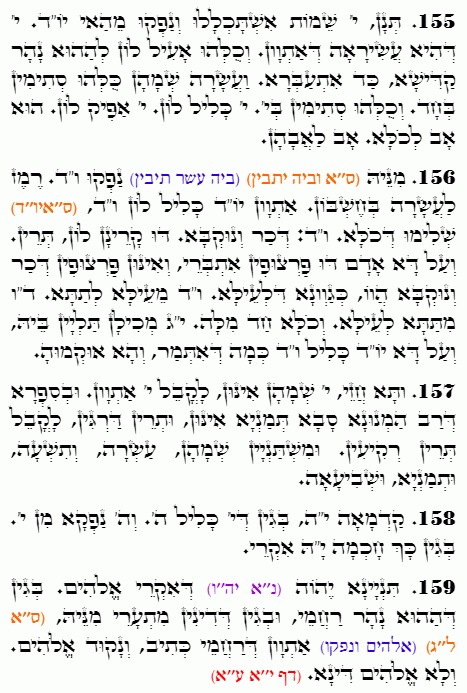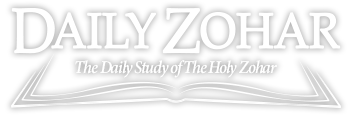Daily Zohar # 4510 – Vayikra – The Holy names formed from the Yod
Daily Zohar 4510

Hebrew translation:
156. מִמֶּנּוּ יָצְאוּ(וּבוֹ יוֹשְׁבִים) (בּוֹ עֶשֶׂר תֵּבוֹת)ו”ד. רֶמֶז לַעֲשָׂרָה בְּחֶשְׁבּוֹן. אוֹתִיּוֹת יוֹ”ד כּוֹלְלוֹת לָהֶן ו”ד(יוֹ”ד), שְׁלֵמוּת הַכֹּל. ו”ד – זָכָר וּנְקֵבָה. דּוּ קוֹרְאִים לָהֶם, שְׁנַיִם. וְלָכֵן אָדָם נִבְרָא דּוּ פַּרְצוּפִים, וְאוֹתָם פַּרְצוּפִים זָכָר וּנְקֵבָה הָיוּ כְּמוֹ שֶׁלְּמַעְלָה. ו”ד מִמַּעְלָה לְמַטָּה. ד”ו מִמַּטָּה לְמַעְלָה, וְהַכֹּל דָּבָר אֶחָד. י”ג מִדּוֹת הָרַחֲמִים תְּלוּיִים בּוֹ, וְעַל כֵּן יוֹ”ד כּוֹלֵל ו”ד כְּמוֹ שֶׁנִּתְבָּאֵר, וַהֲרֵי פֵּרְשׁוּהָ.
157. וּבֹא רְאֵה, עֲשָׂרָה שֵׁמוֹת הֵם כְּנֶגֶד עֶשֶׂר אוֹתִיּוֹת. וּבְסִפְרוֹ שֶׁל רַב הַמְנוּנָא סָבָא הֵם שְׁמוֹנָה, וּשְׁתֵּי דְרָגוֹת כְּנֶגֶד שְׁנֵי רְקִיעִים. וּמִשְׁתַּנִּים הַשֵּׁמוֹת, עֲשָׂרָה, וְתִשְׁעָה, וּשְׁמוֹנָה, וְשִׁבְעָה.
158. הָרִאשׁוֹן – י”ה, מִשּׁוּם שֶׁי’ כּוֹלֶלֶת ה’, וְה’ יוֹצֵאת מִי’. לָכֵן חָכְמָה נִקְרָא י”ה.
159. הַשֵּׁנִי – יֱהֹוִה(יה”ו)שֶׁנִּקְרָא אֱלֹהִים, מִשּׁוּם שֶׁאוֹתוֹ נָהָר רַחֲמִים, וּמִשּׁוּם שֶׁדִּינִים מִתְעוֹרְרִים מִמֶּנּוּ,(אֱלֹהִים וְיָצְאוּ) כְּתוּבוֹת אוֹתִיּוֹת הָרַחֲמִים עִם נִקּוּד שֶׁל אֱלֹהִים, וְלֹא אֱלֹהִים דִּין.
.
Zohar Vayikra
Continued from previous DZ
#155
We have learned that ten names emerged from this Yod, the tenth letter in the alphabet. And all of them, the Yod brought them into that sacred river, Binah, when she was pregnant with them. All ten hidden names are contained in one supreme name and concealed within the Yod that brings them forth as the father of all, the father to the fathers, Chessed, Gevurah, and Tiferet.
#156
From the Yod emerges the Vav-Dalet, which comes from the spelling of the letter and amounts to ten, like the Yod. The Vav-Dalet are male and female, where Zeir Anpin is the Vav and Malchut is the Dalet, which are the male and female aspects of Chokmah, as previously mentioned. They are called “דו” or “duo,” which means two. Therefore, Adam was created with two sides, male and female. The Vav-Dalet are read from above to below, the beginning is the Vav, which is Zeir Anpin, followed by the Dalet, which is Malchut. The דו, “Duo,” is read from below to above, where Malchut is first, followed by Zeir Anpin. And everything is one thing. The thirteen attributes of mercy hang on the Yod. That is, in the upper thorn of the Yod, which is Keter, that holds the thirteen aspects (tikunim) of the beard of Arich Anpin.
#157
The ten names correspond to the ten letters, namely the Yod, which is the tenth of the letters in the alphabet. Therefore, it includes ten letters. In the book of Rabbi Hamnuna Saba, it was said that there are eight names, that is, from Binah and below. The two levels of Keter and Chokmah correspond to the two firmaments, meaning they are hidden and are not called by name. Because a name implies revelation, anything that cannot be grasped, we do not know it by name. The number of names changes to ten when starting from Keter, nine when starting from Chokmah, eight when starting from Binah, and seven when starting from Chessed.
#158
Starting from Chokmah, it is said that the first name is יה Yah, which is Chokmah. Because from the spelling of the Yod comes Vav-Dalet, which forms the shape of the ה H. The H of the YHVH emerges from the Yod, which is Chokmah and becomes Binah. It is found that the two letters Yod-Heh are included in the Yod, which is Chokmah, and for this reason, Chokmah is called יה Yah.
#159
The second name is YHVH, called Elohim, that is, YHVH with the Nikkud of Elohim יֱֱהֹוִה. This represents Binah. Because that river, Binah, is mercy, judgments are aroused from it due to the ascent of Malchut to Binah, and they are not from herself. Therefore, her name is written with the letters of mercy, which are יהוה YHVH, with the Nikkud (vowels) of Elohim, and it is not written with the letters of Elohim, which represent judgment.
{||}

 Previous: Vayikra
Previous: Vayikra


